Crafting Harmony: The Art of Bonsai and Decor
Have you ever felt like your bonsai was saying something profound, something symbolic? It’s that moment of connection that transforms your display into a true work of art.
I remember the first time I curated a bonsai display for my living room. My tiny tree sat proudly in a round pot, its curves perfectly blending with the space. I added weathered stones, which brought a sense of grounding.
And there it was—the symbolism of trees resonated deeply within me. It wasn’t just a hobby; it became a way of life, shaping my perspective.
Our blog, Silent Balance, dives even deeper into these experiences. Join us as we explore the delicate dance of bonsai and traditional decor. From ideal pot shapes to extending the narrative with accessories, each piece adds meaning. Remember, the right stand height can elevate not just your bonsai, but your entire space!
Understanding the Art of Bonsai Display

Bonsai displays aren’t just about showcasing a tree; they’re a delightful dance of artistry, culture, and tradition.
When I set up a display, I immerse myself in bonsai history, using techniques that reflect our rich heritage. Ever heard of the *chinretsu-kai* method? It highlights each bonsai side by side, creating harmony and engagement for viewers. The trees thrive best in a perfect soil mix, which supports their unique growth requirements.
Immersing in bonsai history, I utilize the *chinretsu-kai* method to create harmonious displays that engage and inspire.
I play with aesthetic principles, ensuring balance among the tree, pot, and stand, so every angle captivates. It’s like crafting a masterpiece where simplicity speaks volumes, inviting you to appreciate the artistry of nature’s miniature marvels.
Isn’t that the heart of bonsai? Let’s make every display a moment of awe!
Choosing the Right Pot for Your Bonsai
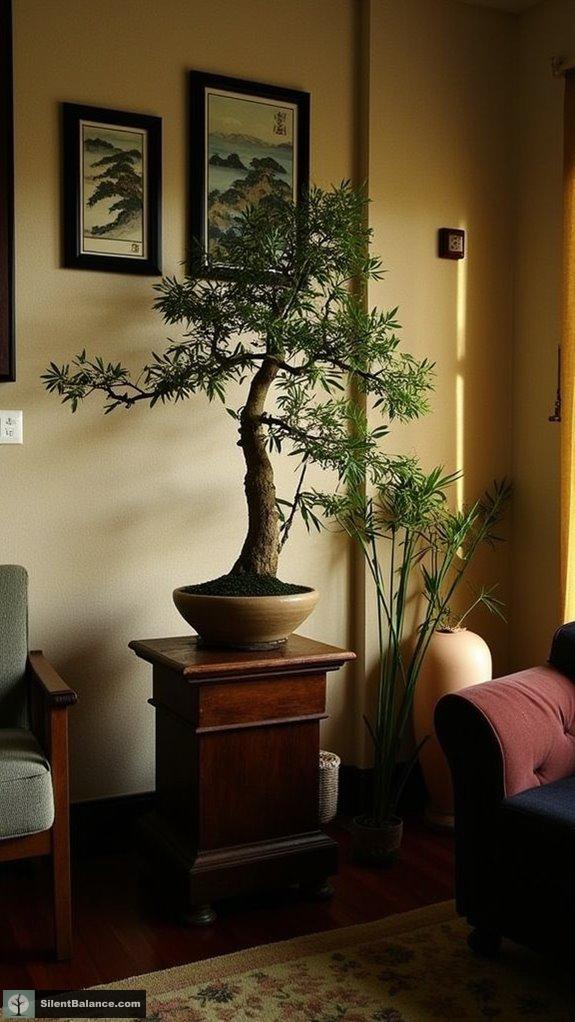
Choosing the right pot for your bonsai can feel like steering through a treasure hunt, especially when you want that perfect blend of style and function.
First off, pot materials matter! High-fired stoneware pots guarantee low water absorption, keeping your tree happy. Regular repotting with root pruning is necessary to maintain the root ball size for healthy growth, as this process rejuvenates the roots and encourages strong growth.
Now, let’s chat pot shapes. Rectangular pots match coarse bark trees’ maturity, while round or oval ones echo smoother forms.
Selecting Complementary Accessories

When you’re crafting the perfect bonsai display, selecting the right accessories can turn your little tree into an enchanting masterpiece.
Consider these unique elements:
- Accessory plantings that mimic nature, creating lush backgrounds.
- Decorative figurines like ceramic cranes that add cultural flair.
- Thoughtful jita selection that compliments your bonsai stand’s shape and style.
- Natural elements like weathered stones to ground your scene authentically.
With the right combo, your bonsai can tell a vibrant story, inviting viewers to engage and explore.
The Importance of Display Height and Stand Selection
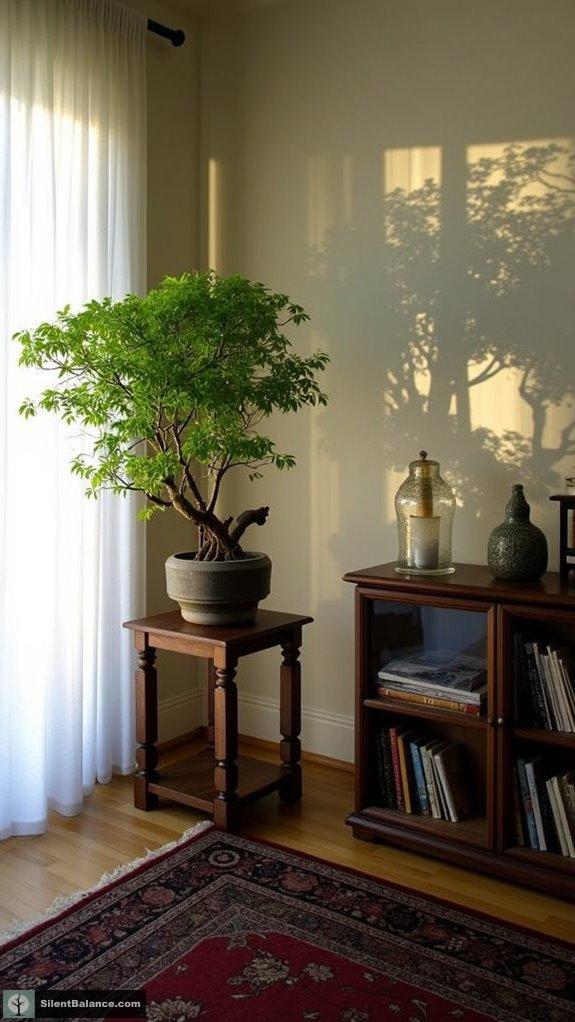
Crafting the perfect display for your bonsai involves more than just having a pretty tree; it’s about finding the right stand that enhances its beauty and tells its story.
Think about display proportions and visual balance. Sturdy, low-profile stands suit thick-trunked trees, while taller stands elevate slim, towering beauties.
Consider the harmony of display proportions—balanced heights and sturdy stands enhance the beauty of your bonsai tree.
Don’t forget about those little shohin-sized gems—they shine best on higher stands.
Choosing the right stand width is key too; it should slightly exceed the bonsai canopy to maintain stability. A little negative space around the bonsai works wonders, emphasizing its elegance.
Creating a Harmonious Tokonoma Display
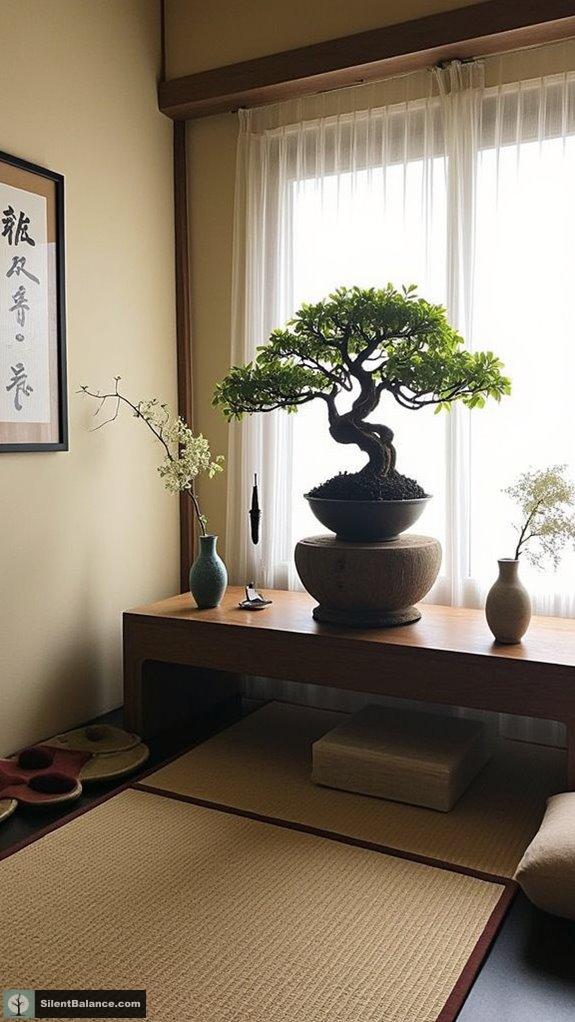
Creating a harmonious tokonoma display is like orchestrating a symphony, where each element plays its own note but harmonizes beautifully with the others.
To achieve this, consider these key components:
- A delicate bonsai, showcasing artistry and patience.
- An elegant calligraphic scroll that inspires reflection.
- Balanced ikebana, bringing a touch of nature’s whimsy.
- Subtle lighting, enhancing the serene ambiance without distraction.
Embrace the tokonoma significance and display etiquette by thoughtfully selecting each piece.
Keep in mind, a well-curated display invites viewers into a meditative journey.
Who wouldn’t want a slice of Zen in their living space? Let your creativity flourish!
Incorporating Seasonal Accents
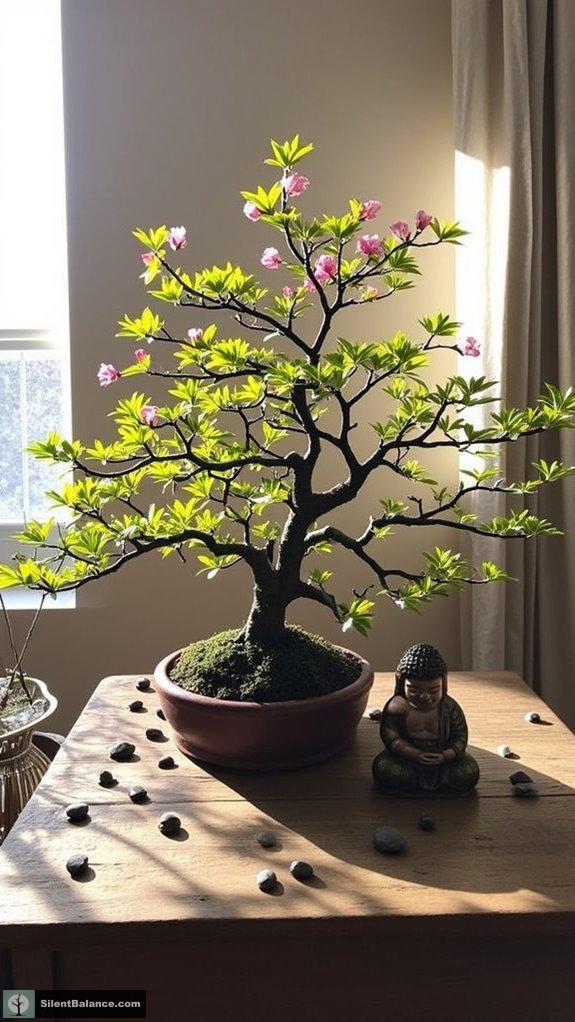
As I think about the beauty of bonsai, it’s hard to ignore how seasonal accents can really elevate a display, adding a fresh spin that reflects nature’s rhythm.
Creating visual balance is essential, and incorporating seasonal variations like spring blossoms or autumn leaves can breathe life into your setup. Think delicate flowers around the base, or splashes of vibrant foliage for that autumn feel.
Want to spice things up? Pair your bonsai with small natural accents, like pebbles or figurines, to create a mini environment.
It’s these thoughtful touches that deepen our connection to the bonsai’s ever-changing journey.
Minimalism in Bonsai Presentation

In bonsai culture, we often chat about refining our displays, and minimalism is like that trendy but timeless fashion choice; it never goes out of style. Emphasizing simplicity not only showcases balance but accentuates the bonsai’s natural beauty.
- Neutral pots complement without overshadowing
- Intentional negative space adds tranquility
- Subtle backgrounds enhance focus
- Elevated stands showcase elegance
Using bonsai maintenance techniques with an eye for minimalism creates stunning visual narratives. By embracing the art of “ma,” I find that emptiness can be just as powerful as the bonsai itself.
Embracing minimalism in bonsai reveals the beauty of simplicity, where even emptiness speaks volumes.
Who knew less could actually be so much more?
Enhancing Aesthetics With Natural Elements
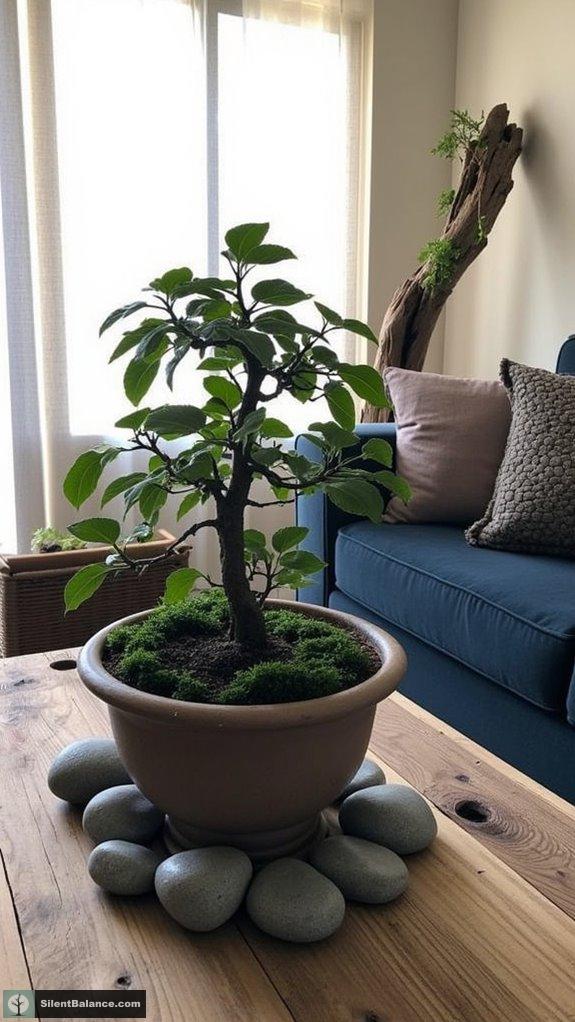
When it comes to enhancing the aesthetics of bonsai displays, the secret often lies in the natural elements we incorporate around our trees.
Think natural stone arrangements that echo rugged mountains, providing harmony without overshadowing your bonsai’s beauty.
Driftwood integration adds character, creating a stunning backdrop that narrates nature’s story of resilience and age.
Why not mix textures with pebbles or moss to tie it all together?
Also, consider accent plants that resonate with the seasons, inviting subtlety and richness.
Trust me, these details create that enchanting atmosphere—even your bonsai will appreciate the extra love!
Showcasing Cultural Significance in Your Decor
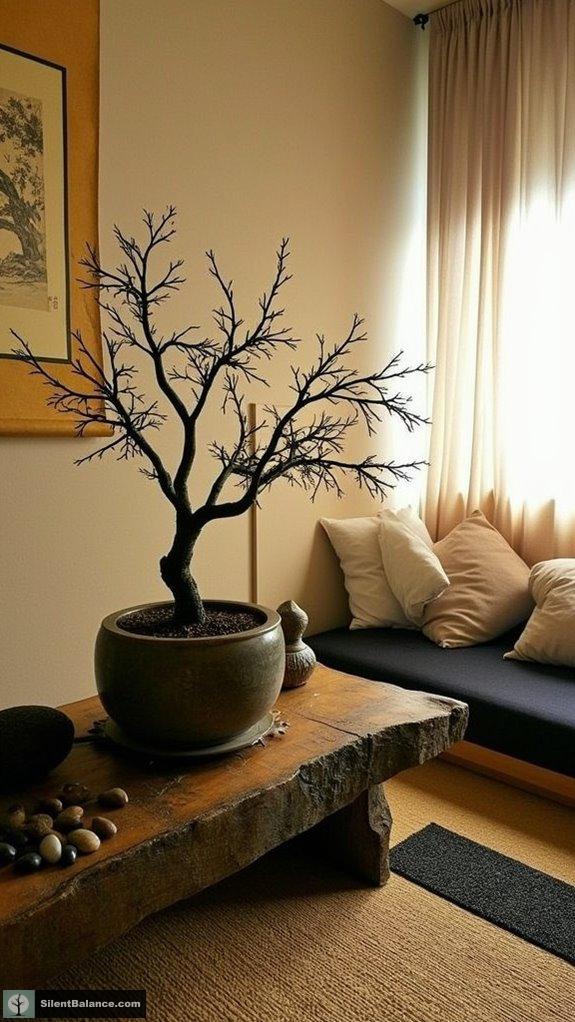
Showcasing the cultural significance of bonsai in your decor creates a truly enchanting atmosphere, don’t you think?
By integrating this art form, you celebrate not only its beauty but also its deep-rooted cultural heritage.
Consider these elements:
- A gracefully displayed bonsai in a tokonoma alcove evokes a sense of peace.
- Natural materials like wood and stone harmonize the entire space.
- Scrolls with Zen-inspired artwork bring thematic depth to your arrangement.
- Think about thoughtful placement for that aesthetic balance, creating tranquil flow.
With a little creativity and care, your decor can resonate with tradition and innovation!
Bonsai Tree Symbolism
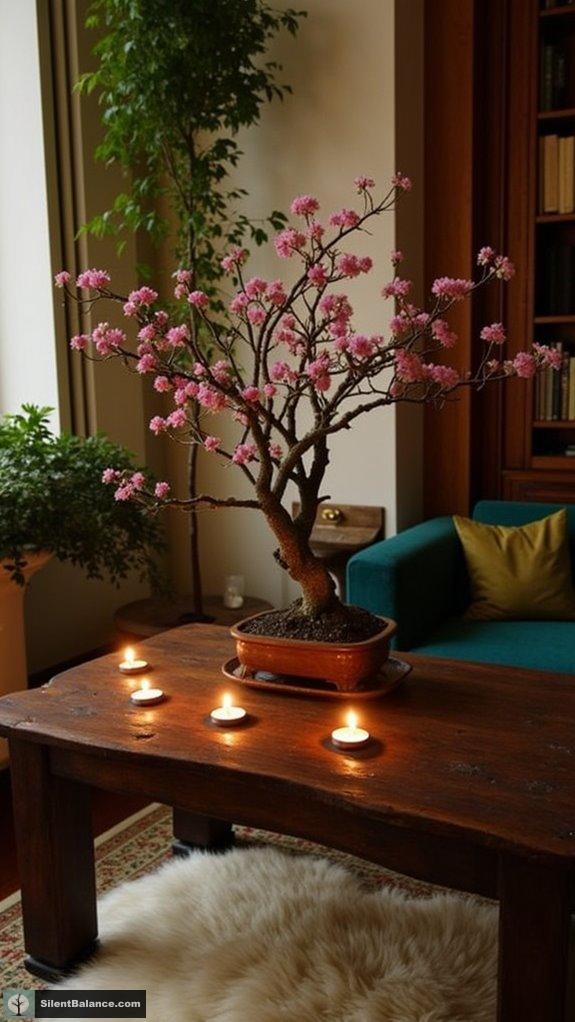
Bonsai trees aren’t just pretty little plants—they’re laden with rich symbolism that whispers tales of harmony and balance with every leaf.
From embodying patience and perseverance to mirroring life’s delicate equilibrium, each bonsai carries profound symbolic meanings.
For example, azalea bonsai exude feminine beauty and love, acting as emotional companions in our lives.
Their cultural significance stretches back over 1,300 years, highlighting a journey of mastery and respect for nature.
Questions and Answers
How Does Climate Affect Bonsai Growth and Display?
Ever wonder how climate shapes bonsai growth? Different climate zones and humidity levels influence tree health and display. I adapt my care strategies to guarantee thriving bonsais, no matter the environment they call home.
What Are the Best Lighting Conditions for Bonsai Displays?
For my bonsai displays, I focus on light intensity and natural light. I make certain they get 6-14 hours of appropriate light daily, balancing blue and red wavelengths for vibrant growth and stunning visuals.
Can Bonsai Displays Be Used Outdoors?
I love using bonsai displays outdoors. They enhance outdoor aesthetics beautifully, blending with natural elements. Watching them thrive under sunlight not only elevates my space but also sparks conversation and delight among friends.
How Often Should Bonsai Be Watered in Display?
“Watering frequency is like a dance; it changes with every step.” I monitor my bonsai’s moisture levels carefully, adjusting daily or every few days based on climate, pot size, and species to guarantee they thrive.
What Are the Common Pests That Affect Bonsai Trees?
Bonsai trees face pests like spider mites, aphids, and scale insects. I practice proactive pest management and disease prevention through regular inspections and treatments, ensuring my bonsai thrive and maintain their stunning beauty.
References
- https://bonsaimirai.com/blog/bonsai-display-pt-i
- https://www.youtube.com/watch?v=-BOZW3AFLsE
- https://www.bonsainut.com/threads/a-primer-on-bonsai-display.6639/
- https://bonsai-en.shop/blogs/tips/bonsai-display
- https://www.bonsaiempire.com/blog/tokonoma-displays
- https://bonsaial.wordpress.com/art-of-display/the-art-of-display-primer/
- https://www.pubs.ext.vt.edu/426/426-601/426-601.html
- https://www.bonsai-shop.com/en/bonsaipots/selection
- https://www.bonsaiable.com/blog/pots-for-bonsai-trees
- https://www.youtube.com/watch?v=dwqMAC59aq8
- Blend Vintage and Modern Decor With Bonsai - September 25, 2025
- Bonsai and Decor: Living Room Design Ideas - September 25, 2025
- Asian-Style Bonsai Displays With Traditional Decor - September 25, 2025

